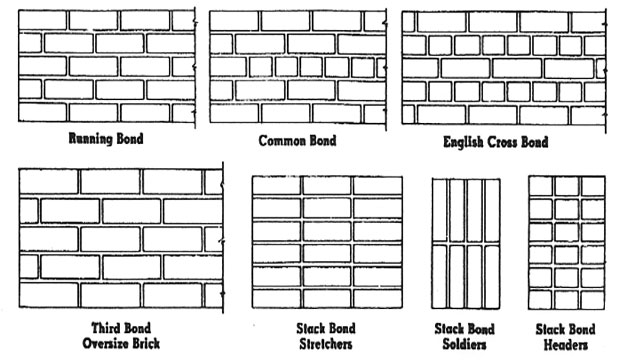
Types of bonds generally found in wall construction developed with brick masonry

On the basis of placing and bonding style of bricks in wall, types of bonds in brick masonry wall construction are categorized. The bonds in brick masonry are built up with the mortar filling among layers of bricks and in grooves if bricks are placed alongside each other and in layers in walls. Cement mortar is a construction material that is extensively utilized for bonds in brick masonry. Lime mortar and mud mortar are also very popular construction materials in brick masonry.
Types of Bonds in Brick Masonry Wall Construction :
Generally, the following types of bonds are used in brick masonry:
- Stretcher bond
- Header bond
- English bond
- Flemish bond
Other Types of bonds are:
- Facing bond
- Dutch bond
- English cross bond
- Brick on edge bond
- Raking bond
- Zigzag bond
- Garden wall bond
1. Stretcher bond
Extended narrow face of the brick is defined as stretcher demonstrated underneath in the elevation of figure. Stretcher bond alias running bond, is developed when bricks are placed with only their visible stretchers that overlaid in the middle with the courses of bricks underneath and above.
Stretcher bond in the brick belongs to the easiest repeating pattern. But there is restriction of stretcher bond as it is unable to make strong binding with adjoining bricks in complete width thick brick walls. These can be applied perfectly for one-half brick thick walls, as for instance toward the development of half brick thick partition wall.
Walls built up with stretcher bonds are not so powerful to withstand individually in longer span and height. So, there should be supporting structure like brick masonry columns at regular spacing.
Generally, stretcher bonds are utilized in the steel or reinforced concrete framed structures like the outer facing. These can be also applied as the outer facing of cavity walls. These types of walls also developed for boundary walls, gardens etc.
2. Header bond
Header refers to the smaller square face of the brick that is measured with 9cm x 9cm. Header bond is also called as heading bond. In header bonds, all bricks in a single course are set as headers on the faces of the walls. The stretcher bond is applied for developing the walls of half brick thickness but header bond is applied for building up the walls having complete brick thickness of 18cm. In header bonds, the overlaying remains identical to half width of the brick. For this purpose, three quarter brick bats are utilized in alternate courses as quoins.
3. English BondEnglish bond in brick masonry contains one course of stretcher only as well as a course of header over it. So, there are two alternating courses of stretchers and headers for it. Headers are placed in the center line on the stretchers in course underneath and each alternate row is organized vertically.
To rupture the sequence of vertical joints, quoin closer is applied initially and end of a wall next to first header. A quoin close is a brick that is sliced lengthwise into two halves and applied at corners in brick walls.
To get more information, visit theconstructor.org


